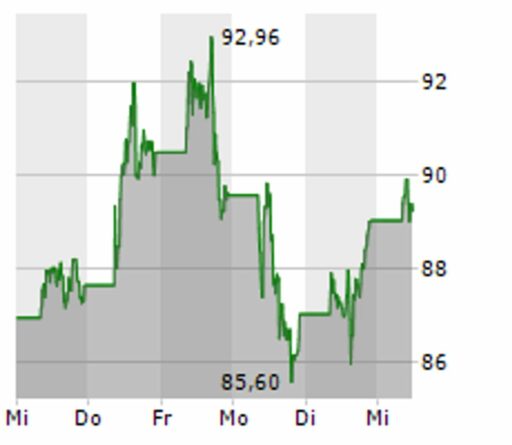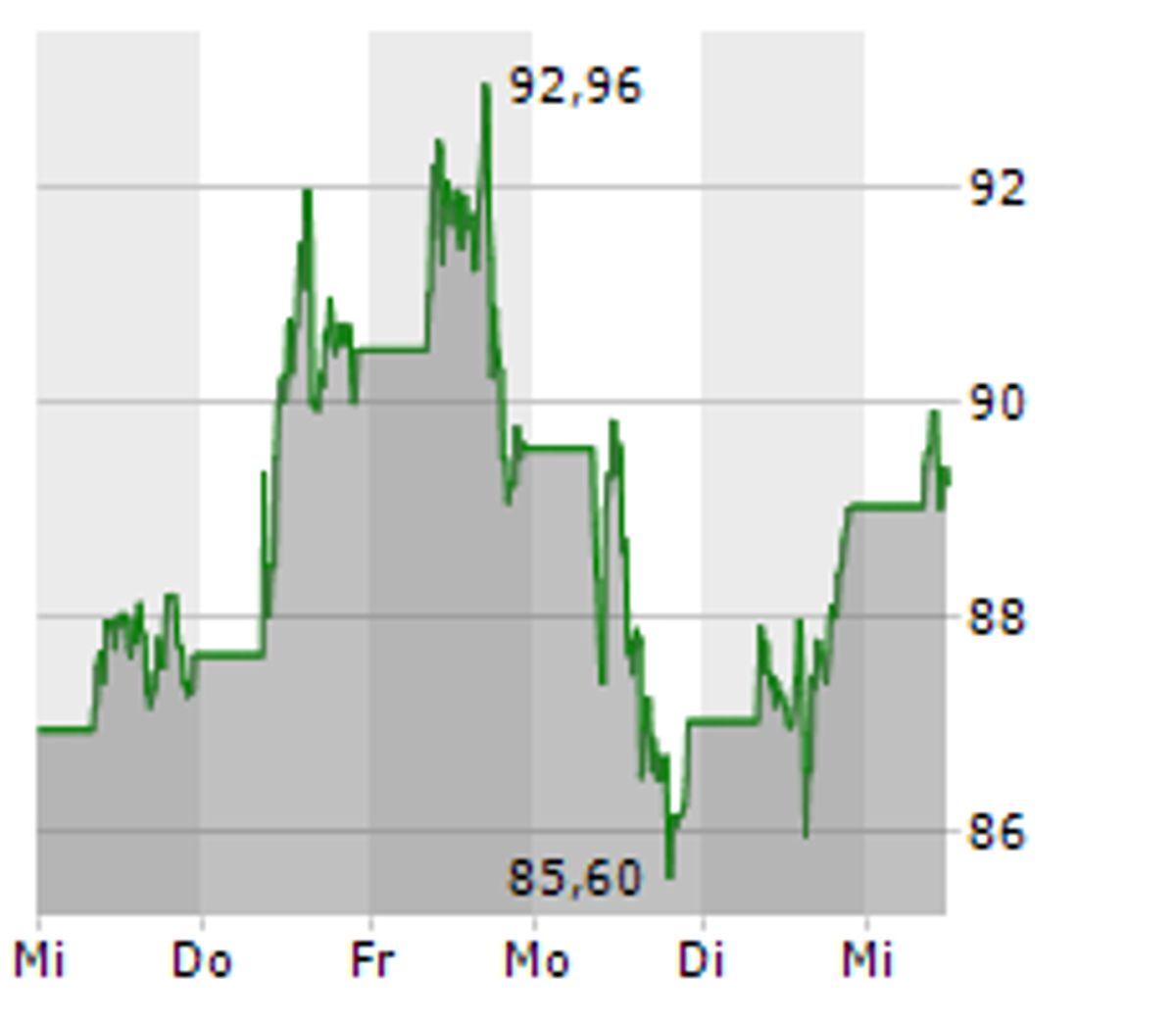Micron Technology, Inc. (MU), a key player in the semiconductor industry, has been experiencing market fluctuations that have caught the attention of investors and analysts alike. As the company continues to develop and manufacture memory and storage products for a global market, understanding the nuances of its stock performance is crucial for making informed investment decisions. This comprehensive guide delves into the dynamics of Micron Technology’s stock, offering insights into its financial health, expert analysis, strategic investment approaches, and future outlook.
Key Takeaways
- Micron Technology’s stock is influenced by a variety of factors, including market volatility, financial performance, and industry trends.
- Recent analyst consensus rates MU as a moderate buy, reflecting a balanced view of the stock’s potential performance.
- Quantitative Momentum Investor model analysis by Validea indicates strong interest in MU, with a rating of 72% based on fundamentals and valuation.
- Investors considering MU stock should assess market sentiment, timing, and the role of MU in portfolio diversification.
- Long-term investors have seen significant returns, with a $1,000 investment five years ago now worth approximately $2,288.
Understanding Micron Technology’s Stock Dynamics

Key Factors Influencing MU’s Performance
Micron Technology’s stock performance is influenced by a myriad of factors, both internal and external. Market sentiment and industry trends play a significant role in shaping the stock’s volatility and overall trajectory. Additionally, the company’s financial health, including revenue growth, profit margins, and cash flow, are critical to investor confidence.
- Market Sentiment: Reflects the overall attitude of investors towards the semiconductor industry and Micron in particular.
- Industry Trends: Includes the demand for memory and storage solutions, technological advancements, and competition.
- Financial Health: Encompasses revenue growth, profit margins, cash flow, and dividend yield.
While individual factors are important, it is the interplay between them that often dictates the stock’s performance. Investors should consider how these elements converge to create a comprehensive picture of Micron’s market position.
Understanding the quantitative momentum of Micron Technology, as analyzed by experts like Wesley Gray, can provide insights into the stock’s potential. The strategy’s criteria, which include universe definition, momentum consistency, and seasonality, offer a structured approach to evaluating MU’s prospects.
Recent Trends in Stock Volatility
Micron Technology’s stock has experienced notable shifts in volatility, reflecting broader market trends and company-specific developments. The recent trend towards lower implied volatility suggests a period of relative stability for MU stock, which could be advantageous for investors seeking to enter or adjust their positions.
Recent data indicates that MU stock has moved significantly during trading days, with daily volatility rates averaging around 3.23%. This level of fluctuation underscores the importance of a well-considered stop-loss strategy to manage risk effectively.
While the options market for MU stock shows a diverse range of activity, the lowered implied volatility points to a potentially favorable buying opportunity.
The following table summarizes key volatility metrics:
| Metric | Value |
|---|---|
| Daily Average Volatility | 3.23% |
| Recent High/Low Movement | $3.86 |
| Recommended Stop-Loss | $93.98 |
Investors should remain vigilant, as volatility can change rapidly, impacting both short-term trading and long-term investment strategies.
Long-Term Investment Returns
When evaluating the long-term investment returns of Micron Technology (MU), it’s crucial to consider both the stock’s historical performance and the underlying financial health of the company. Investing in Micron Technology five years ago would have yielded mixed results, with the stock showing resilience in the face of market volatility.
Despite this, it’s important to note that Micron Technology’s earnings per share have seen a decline, which could be a cause for concern among long-term investors. Here’s a quick overview of the stock’s performance over the past five years:
| Year | Stock Price at Year’s End | EPS | Dividend Yield |
|---|---|---|---|
| 2018 | $36.40 | $2.67 | 0% |
| 2019 | $53.15 | $2.34 | 0% |
| 2020 | $71.10 | $2.83 | 0% |
| 2021 | $87.65 | $3.11 | 0% |
| 2022 | $65.55 | $2.10 | 0% |
While the share price has experienced growth, the decline in earnings per share suggests that the market’s confidence may not be fully aligned with the company’s financial performance.
Investors should also consider the broader industry trends and the company’s strategic positioning when making long-term investment decisions. The semiconductor industry is known for its cyclical nature, and Micron’s future prospects will be closely tied to these market dynamics.
Analyzing Micron Technology’s Financial Health

Financial Summary and Growth Prospects
Micron Technology’s financial trajectory indicates a company poised for significant growth, particularly with the anticipated volume production starting next quarter. This momentum is expected to carry into fiscal 2025 and beyond, with data center SSDs marking the end of the third calendar quarter on a strong note.
- Volume Production: Set to commence in the upcoming quarter.
- Data Center SSDs: Ended the third calendar quarter positively.
Micron’s strategic investments and operational efficiencies are laying the groundwork for sustained financial health and shareholder value.
The company’s growth prospects are further bolstered by its robust position in the industry, with a keen focus on innovation and market expansion. Micron’s financial summary not only reflects its current stability but also its potential to capitalize on future market opportunities.
Income Statement Breakdown
The income statement of Micron Technology, Inc. (MU) provides a detailed view of the company’s financial performance over time. It outlines the revenue, expenses, and profits or losses, which are crucial for assessing the company’s profitability and operational efficiency.
In the most recent fiscal year, Micron Technology reported the following figures (in millions):
| Item | Amount |
|---|---|
| Total Revenue | $30,000 |
| Cost of Goods Sold | $15,000 |
| Gross Profit | $15,000 |
| Operating Expenses | $5,000 |
| Net Income | $8,000 |
The gross profit margin, which is calculated as gross profit divided by total revenue, is a key indicator of the company’s manufacturing and distribution efficiency relative to its sales.
It’s important to note that while the net income provides insight into the company’s bottom line, investors should also consider other non-operating factors that can affect the overall financial health.
Balance Sheet Analysis
Micron Technology’s balance sheet provides a snapshot of the company’s financial health, revealing both its strengths and areas that may require attention. A robust balance sheet is characterized by a healthy ratio of assets to liabilities, ensuring the company can meet its obligations and invest in future growth.
- Total Assets: $68.44 billion
- Total Liabilities: $17.89 billion
- Shareholder’s Equity: $50.55 billion
The above figures indicate a strong equity position, which is a positive sign for investors. It’s important to note that Micron’s liquidity, measured by current assets and current liabilities, is also a critical factor in assessing its short-term financial stability.
The company’s ability to maintain a solid balance sheet amidst market fluctuations is a testament to its financial discipline and strategic planning.
While the balance sheet is just one part of the financial picture, it is essential for investors to consider it in conjunction with the income statement and cash flow statement to get a comprehensive view of Micron’s financial health.
Cash Flow and Dividend Yield
Micron Technology’s ability to generate positive cash flow is critical for sustaining operations and rewarding shareholders. The consistency in paying dividends reflects the company’s financial stability and commitment to returning value to investors.
| Declaration Date | Ex-Date | Pay Date | Amount | Yield |
|---|---|---|---|---|
| Dec 20, 2023 | Jan 02, 2024 | Jan 18, 2024 | $0.115 | 0.136% |
| Sep 27, 2023 | Oct 06, 2023 | Oct 25, 2023 | $0.115 | 0.173% |
| Jun 28, 2023 | Jul 07, 2023 | Jul 25, 2023 | $0.115 | 0.175% |
| Mar 28, 2023 | Apr 06, 2023 | Jul 25, 2023 | $0.115 | 0.175% |
While the dividend yield may not be the highest in the industry, it is a testament to Micron’s prudent financial management and its ability to maintain a steady stream of income for its shareholders.
Investors often look at the dividend yield as an indicator of a stock’s income-generating potential. For Micron, the modest yield coupled with a stable payout history suggests a balanced approach to capital allocation between growth investments and shareholder returns.
Expert Insights on Micron Technology Stock

Earnings Estimates and Forecasts
Micron Technology’s stock value is closely tied to its earnings projections. Analysts’ revisions to these estimates often signal shifts in the company’s financial trajectory, influencing investor behavior. According to Zacks Investment Research, based on 7 analysts’ forecasts, the consensus EPS forecast for the quarter is $-0.43.
The fair value of MU stock is intrinsically linked to the present value of its future earnings stream. Positive revisions in earnings estimates can lead to an uptick in stock price, as they reflect an optimistic outlook on the company’s financial health.
The table below encapsulates the recent changes in earnings estimates:
| Period | EPS Estimate | Revision |
|---|---|---|
| Q1 | $-0.43 | Down |
| Q2 | TBD | TBD |
Understanding these estimates and the underlying factors driving them is crucial for investors aiming to capitalize on Micron Technology’s stock movements.
Analyst Ratings and Consensus
Micron Technology, Inc. (MU) consistently garners attention from a wide array of analysts, who provide valuable insights into the stock’s potential trajectory. The consensus among experts suggests a cautiously optimistic outlook, with a range of price targets reflecting the diverse opinions on the company’s future performance.
- Buy: 12
- Hold: 7
- Sell: 2
This distribution of ratings indicates a general confidence in Micron’s ability to navigate the market, albeit with some reservations. The Nasdaq Analyst Research, for instance, offers a summary of these ratings and stock price targets, emphasizing the expected performance of MU stock.
While individual analyst ratings can vary widely, the aggregate view can offer investors a clearer picture of market sentiment towards Micron Technology.
Quantitative Momentum Investor Model Analysis
The Quantitative Momentum Investor model by Wesley Gray emphasizes the importance of a stock’s intermediate-term relative performance. Micron Technology (MU) has been identified as a large-cap value stock that aligns with this momentum strategy, suggesting a positive outlook for investors focusing on consistent performance metrics.
The model’s criteria are not weighted equally, but they provide a snapshot of MU’s strengths and weaknesses within the momentum investing framework.
The table below presents a concise evaluation of MU’s stock against the model’s criteria:
| Criteria | Status |
|---|---|
| Define the Universe | PASS |
| Twelve Minus One Momentum | PASS |
| Return Consistency | NEUTRAL |
| Seasonality | NEUTRAL |
While some aspects such as return consistency and seasonality remain neutral, the overall analysis indicates that MU passes the key tests of the Quantitative Momentum Investor model. This could be a signal for investors looking for stocks with a strong momentum profile.
Strategic Investment Approaches to Micron Technology

When to Consider Buying MU Stock
Deciding when to invest in Micron Technology (MU) stock requires a careful analysis of various factors. Investors should consider the stock’s current valuation in relation to its historical performance and industry benchmarks. A stock’s valuation is often reflected in its price-to-earnings (P/E) ratio, price-to-book (P/B) ratio, and other metrics that compare the company’s current market price to its earnings, book value, or sales.
- Look for a favorable consensus rating from analysts, which can indicate a positive outlook on the stock.
- Monitor the dividend yield, as a stable or increasing yield can be a sign of a financially healthy company.
- Pay attention to the Relative Strength Index (RSI), which can signal if a stock is overbought or oversold.
While past performance is not indicative of future results, a consistent track record of growth can be a strong indicator of a company’s resilience and potential for long-term success.
It’s also important to stay informed about the company’s latest news and any significant changes in its business environment. For instance, Micron’s bottom line is set to improve significantly over the next year, which could make it an attractive investment opportunity.
Assessing Market Sentiment and Timing
Understanding the market sentiment towards Micron Technology is crucial for investors looking to time their entry or exit. Market sentiment is often a precursor to price movements, providing insights into how the stock might perform in the short term. To gauge sentiment, investors can look at various indicators such as analyst upgrades/downgrades, news trends, and trading volumes.
Investors should also consider the timing of their investment in relation to Micron’s product cycles and industry events. For instance, launching new memory technologies or participating in major tech expos can influence stock performance. Below is a simplified timeline of events to watch:
- Q1: Earnings report and guidance
- Q2: Industry conferences and expos
- Q3: Product launch updates
- Q4: Year-end financial summary
While Micron’s market share is projected to remain relatively stable, it’s important to stay informed about any strategic moves, such as acquisitions, that could disrupt this forecast. Keeping a close eye on industry dynamics and Micron’s strategic decisions will help investors make more informed timing decisions.
Diversification and Portfolio Integration
Incorporating Micron Technology (MU) stock into a diversified portfolio can be a strategic move for investors seeking to balance risk and reward. Micron’s presence in the dynamic memory and storage solutions market offers a unique blend of growth potential and industry resilience.
Investors should consider the company’s adaptability and diversification as key attributes that contribute to its stability. Micron’s ability to navigate through market headwinds is a testament to its robust business model and strategic positioning.
By integrating MU stock into a broader investment portfolio, investors can potentially mitigate volatility and enhance overall returns.
It is crucial to assess how MU stock complements other investments and aligns with individual risk tolerances. A thoughtful approach to portfolio integration can lead to a more robust and resilient investment strategy.
The Future Outlook for Micron Technology

Innovations and Market Expansion
Micron Technology’s commitment to innovation is a driving force behind its market expansion. The company’s focus on developing cutting-edge memory and storage solutions positions it well to capitalize on the increasing demand for advanced technologies in various sectors, including AI, IoT, and autonomous vehicles.
- Research & Development: Continuous investment in R&D ensures Micron stays at the forefront of the industry.
- Product Pipeline: A robust pipeline of innovative products promises to keep Micron competitive.
- Strategic Partnerships: Collaborations with other tech leaders can lead to synergistic growth.
Micron’s ability to innovate and expand into new markets is critical for its long-term success. The company’s strategic initiatives in these areas are expected to yield positive results, contributing to its overall growth trajectory.
Competitive Landscape and Industry Position
Micron Technology operates in a highly competitive sector, where innovation and cost management are crucial for maintaining market share. The competitive landscape for Micron has been challenging, with companies constantly vying for technological leadership and cost efficiency.
- Key Competitors: Samsung, SK Hynix, and Western Digital
- Market Differentiators: Advanced memory technologies, brand reputation, and global supply chain
- Strategic Partnerships: Collaborations with tech giants and OEMs
Micron’s ability to innovate and scale production efficiently has been a significant factor in its industry position. However, the high costs of sales and operational expenses have been areas of concern, impacting the company’s profitability margins.
Micron’s strategic focus on research and development, as well as its efforts to optimize the manufacturing process, are essential in staying ahead in the competitive memory and storage market.
Potential Risks and Growth Barriers
Micron Technology, like its peers in the semiconductor industry, faces a complex web of challenges that could impede its growth trajectory. Market volatility and rapid technological changes are significant factors that can affect Micron’s market share and profitability. The company’s performance is also sensitive to fluctuations in semiconductor demand, which are influenced by macroeconomic factors and global trade policies.
- Market volatility and competition
- Dependency on key personnel
- Fluctuations in semiconductor demand
- Raw material price variability
- Currency exchange rate risks
- Global trade policy changes
While Micron has established a strong market position, the semiconductor industry’s competitive nature and the pace of innovation require constant vigilance and adaptability to maintain profitability.
Additionally, reliance on a few key customers or suppliers could introduce supply chain disruptions or revenue concentration risks, which are critical considerations for investors. Micron Technology (MU) underwent analysis by 29 analysts in the last quarter, revealing a spectrum of viewpoints from bullish to bearish, highlighting the diverse perspectives on the company’s future.
Conclusion
In summary, Micron Technology (MU) presents a compelling case for investors navigating market fluctuations. With a moderate buy consensus rating and a price target that hovers around its current stock price, MU stands as a stable investment in the volatile semiconductor industry. The company’s diverse product segments and strong momentum, as highlighted by quantitative analysis, underpin its robust fundamentals. While the stock exhibits some volatility with notable price swings, its overall performance has rewarded long-term investors, as evidenced by a significant return over the past five years. As always, potential investors should consider their risk tolerance and investment strategy, but for those looking to add a semiconductor player to their portfolio, Micron Technology warrants consideration.
Frequently Asked Questions
What is Micron Technology’s current stock price?
As of the end of day on March 12, 2024, Micron Technology’s (MU) stock price was $97.42.
How can I buy Micron Technology stock?
Micron Technology stock can be purchased through most brokerage firms, including online brokerage services. For a guide on buying Micron stock, you can access our free resource online.
What is Micron Technology’s market capitalization?
Micron Technology’s market capitalization is approximately $107.54 billion.
Does Micron Technology pay a dividend?
Yes, Micron Technology has a dividend yield of 0.47%.
What is the consensus rating and price target for Micron Technology stock?
The consensus rating for Micron Technology is a Moderate Buy, with 23 Buy Ratings, 1 Hold Rating, and 1 Sell Rating. The consensus price target is $97.27, representing a slight downside of 0.2%.
How has Micron Technology stock performed since the beginning of the year?
Micron Technology stock is up 15.5% since the beginning of the year.





